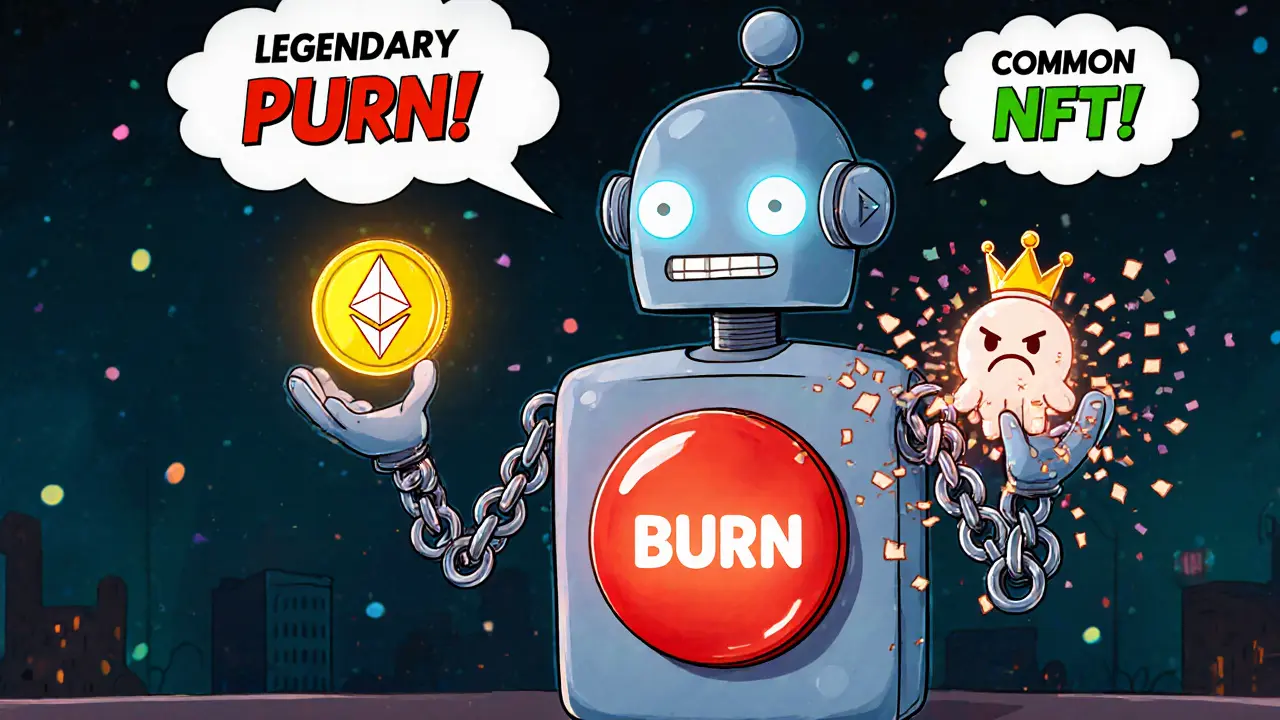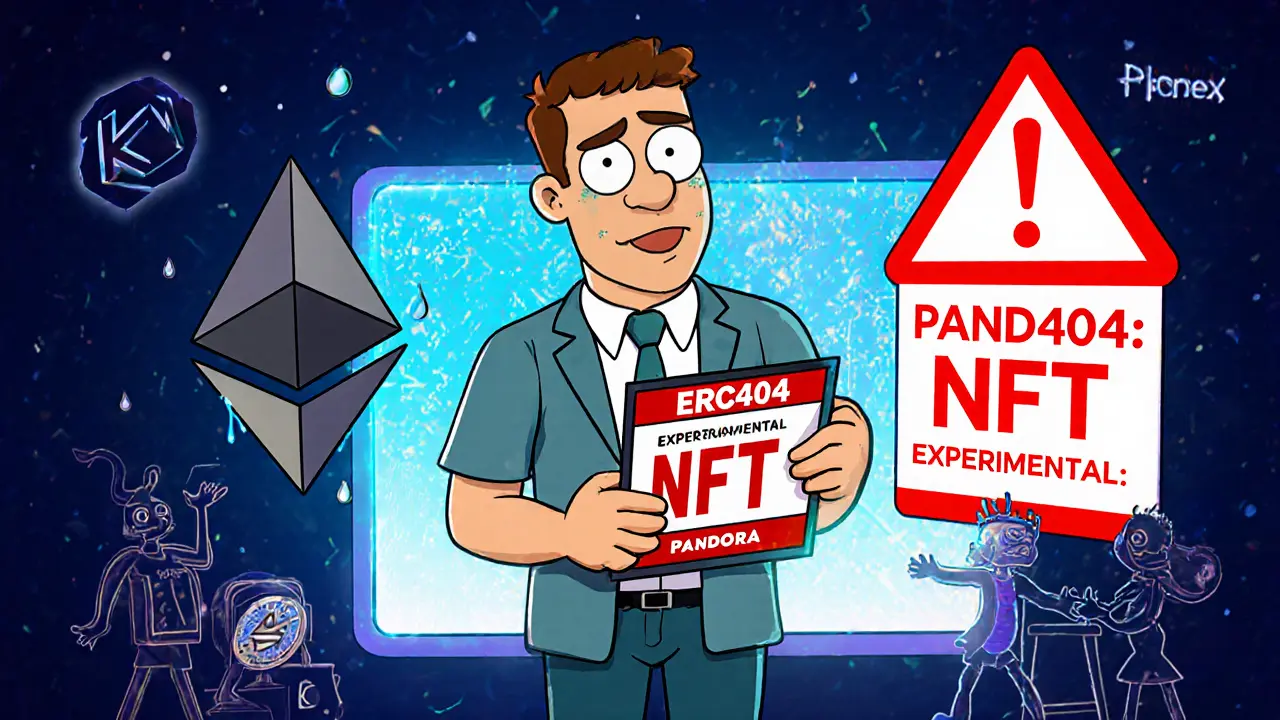PANDORA NFT Rarity & Value Calculator
PANDORA tokens come with a free NFT every time you buy one. Each NFT has a rarity level with specific probabilities. This calculator shows:
- Probability of each rarity level
- Potential value ranges based on current market data
- Important risks to consider
NFT Rarity Probabilities
75% Chance
$1 - $5
20% Chance
$5 - $15
4.9% Chance
$15 - $50
0.1% Chance
$50 - $500+
Estimated NFT Value
Enter a token price to see your potential NFT value
Probability: 0% Common, 0% Rare, 0% Epic, 0% Legendary
Important: When you sell your PANDORA token, the NFT is permanently burned. No recovery options available. Always double-check before selling.
There is no such thing as a "Pandora crypto exchange." That name doesn’t exist. If you’re searching for it, you’ve likely been misled by confusing blog posts, forum threads, or YouTube videos mixing up the name of a token with a fake exchange. The real story is about PANDORA, an experimental crypto token built on Ethereum using a brand-new, unproven standard called ERC404. It’s not an exchange. It’s a token that comes with a free NFT every time you buy it. And that’s where things get complicated - and risky.
What Exactly Is PANDORA?
PANDORA is not Bitcoin. It’s not Ethereum. It’s not even a typical ERC20 token like USDT or UNI. It’s a hybrid. Every time you buy one PANDORA token, you automatically get a unique NFT tied to it. Think of it like buying a concert ticket that also gives you a limited-edition poster - except the poster can be sold separately, and if you sell the ticket, the poster disappears.
This hybrid model is built on ERC404, an experimental standard that merges ERC20 (fungible tokens) and ERC721 (NFTs). It’s not officially recognized by the Ethereum Foundation. In fact, as of May 2025, Ethereum’s core team said they won’t endorse ERC404 until it passes serious security audits. That’s a red flag. You’re investing in something that’s still in beta.
How It Works - And Why It’s Confusing
Here’s the basic flow: You buy 1 PANDORA token on KuCoin or Phemex. You get 1 token in your wallet. But you also get 1 NFT - and it has a rarity level: common (75% chance), rare (20%), epic (4.9%), or legendary (0.1%). The NFT is stored on-chain, linked to your token. If you sell your PANDORA token, the NFT burns. Gone forever. No backup. No recovery.
That’s the catch. Most people don’t realize this until they try to sell. Reddit user u/BlockchainNewbie spent three hours trying to recover a lost NFT after moving wallets. The interface doesn’t warn you clearly. KuCoin’s own support data shows 63% of PANDORA-related tickets are about users losing track of their NFTs. You’re not just managing a token. You’re managing two assets in one. And most wallets don’t handle this well.
Where Can You Buy It?
You can’t buy PANDORA on Binance, Coinbase, or Kraken. It’s only listed on seven exchanges total, and only two have decent support: KuCoin and Phemex. Even then, KuCoin’s user satisfaction score for PANDORA support is just 3.1 out of 5. Phemex scores 4.2 - better, but still not great.
To buy it, you need an Ethereum wallet that supports both ERC20 and ERC721. MetaMask version 10.18 or higher is recommended. Hardware wallets like the Ledger Nano X (firmware 2.3.0+) work too, but only if you manually check both token and NFT balances. Most users skip this step - and end up confused.

The Numbers Don’t Lie - It’s High Risk, High Reward
PANDORA has a max supply of 10,000 tokens. Only 8,500 are available to the public. The rest are locked for development. As of May 2025, the average daily trading volume is $2.3 million - tiny compared to major coins. But here’s the twist: 78% of that volume comes from whales holding more than 100 tokens each. That means the price can swing wildly based on just a few big players.
The token trades mostly against ETH (82%) and USDT (18%). Its price has hovered between $120 and $450 since launch, but the real value isn’t in the token - it’s in the NFT. One user bought five PANDORA tokens and got a legendary NFT that jumped 220% in value on Blur marketplace. That’s the dream. But the other four NFTs? They’re common. Worth maybe $5 each.
Security Risks You Can’t Ignore
ERC404 is untested. And that’s dangerous. In March 2024, security researcher Alex Kim found three critical bugs in early ERC404 contracts. One allowed token and NFT balances to desync during Ethereum network congestion. That means you could think you own a token, but your NFT disappears - and no one can fix it.
Then came the Bybit hack in February 2025, where $1.5 billion in ETH was stolen. Security firms like Chainalysis started digging into experimental tokens like PANDORA. They found that the token-NFT sync process creates a 37% larger attack surface than normal tokens. That’s not a small number. It means more ways for hackers to exploit the system.
Even exchanges have responded. KuCoin and Phemex added mandatory confirmation screens in May 2025. Now, before you sell, you have to check both the token and NFT values. But that’s a band-aid. It doesn’t fix the underlying code.
Who Should Avoid PANDORA?
If you’re new to crypto, walk away. This isn’t a beginner project. It requires understanding wallets, NFTs, Ethereum gas fees, and smart contract risks. You need to know how to check your NFT balance separately from your token balance. You need to know what happens when you sell. You need to know that if you mess up, there’s no customer service that can restore your NFT.
Also avoid it if you need fast transactions. PANDORA trades take an average of 28.7 seconds to confirm - almost double the time of a regular Ethereum transaction. That’s because every trade has to verify both the token and the NFT. If you’re day trading or need speed, this will frustrate you.

Who Might Benefit?
If you’re an experienced NFT collector who also wants liquidity, PANDORA might be worth a small gamble. The dual-asset structure lets you sell the token for cash while holding onto the NFT - or vice versa. It’s the only token that lets you do that without using a marketplace.
Some collectors use tools like NFTBank.io to track their PANDORA NFTs. That helps. But it’s still a manual process. You’re not buying an investment. You’re buying a digital artifact with a side of speculation.
Regulatory Shadow
The SEC hasn’t taken action yet, but its April 2024 guidance warned that hybrid tokens like PANDORA could be classified as securities. Why? Because they’re sold with the promise of future value - both from the token price and the NFT rarity. If the SEC steps in, exchanges may be forced to delist it. That could crash the price overnight.
And if Ethereum officially rejects ERC404? Then PANDORA becomes a relic. No updates. No upgrades. Just a dead token with a bunch of NFTs no one can trade.
The Bottom Line
PANDORA isn’t a scam. It’s not a Ponzi. But it’s not a safe investment either. It’s a high-risk experiment wrapped in hype. The idea is clever - combining tokens and NFTs - but the execution is fragile. The technology is unproven. The user experience is messy. The support is poor. And the market is controlled by a handful of whales.
If you’re curious, put in less than 1% of your crypto portfolio. Use a hardware wallet. Learn how to check your NFTs manually. Don’t expect to get rich. And never, ever sell your token without double-checking that you’re okay with losing the NFT.
There’s no exchange called Pandora. There’s only a token that plays with fire. And right now, the fire is still burning - but the kindling is wet.
Is there a real exchange called Pandora Crypto?
No, there is no exchange named Pandora Crypto. The term comes from confusion between the PANDORA token and the phrase "Pandora’s box," often used in cybersecurity articles. PANDORA is a token traded on exchanges like KuCoin and Phemex, not a platform itself.
Where can I buy the PANDORA token?
You can buy PANDORA on KuCoin and Phemex. It’s not listed on Binance, Coinbase, Kraken, or any major U.S.-based exchange. Only seven exchanges support it as of mid-2025, and only two offer decent documentation.
Does buying PANDORA give me an NFT?
Yes. Every PANDORA token purchase automatically mints a unique NFT with a rarity level: common, rare, epic, or legendary. The NFT is stored on-chain and linked to your token. Selling the token burns the NFT - permanently.
Is PANDORA safe to invest in?
It’s high risk. The ERC404 standard is experimental and not endorsed by Ethereum. Security researchers have found critical vulnerabilities. There’s no guarantee the token or NFTs will retain value. Only experienced users with hardware wallets and NFT tracking tools should consider it.
Why do PANDORA transactions take so long?
Each transaction must verify both the ERC20 token and the ERC721 NFT, doubling the processing time. Average confirmation time is 28.7 seconds, compared to 14.2 seconds for standard Ethereum transactions.
Can I recover my PANDORA NFT if I lose it?
No. If you sell your token, the NFT burns. If your wallet crashes or you migrate incorrectly, there’s no recovery mechanism. The system is designed to be irreversible. Always double-check before acting.
Is PANDORA a good long-term investment?
Unlikely. ERC404 has a 15% survival rate projected beyond 2026, according to Gartner. Without official Ethereum support, PANDORA could become obsolete. It’s a speculative play, not a long-term asset.

Brian Gillespie
November 12, 2025 AT 04:41This token is a minefield.
Michelle Elizabeth
November 13, 2025 AT 15:48Oh sweet merciful heavens, another ‘decentralized innovation’ that’s just a glitter-covered dumpster fire. ERC404? More like ERC-‘Oops-I-Just-Burned-My-NFT’.
People treat this like it’s the next Bitcoin when it’s basically a magic trick where the rabbit is your digital soul and the hat is a poorly audited smart contract.
I bought one. Got a ‘legendary’ NFT of a cat wearing a top hat. Worth $200. The other four? Common. One’s just a pixelated potato. I cried.
KuCoin’s ‘mandatory confirmation’ screen? That’s like putting a stop sign at the edge of a cliff and calling it safety. The cliff is still there.
And don’t get me started on the ‘whales’-they’re not investors, they’re auctioneers with wallets full of ETH and zero empathy.
This isn’t crypto. It’s performance art where the audience pays to watch themselves get scammed.
Also, the fact that you can’t even recover your NFT if your phone dies? That’s not innovation. That’s cruelty with gas fees.
Kylie Stavinoha
November 13, 2025 AT 16:29The philosophical tension here is fascinating: PANDORA forces us to confront the ontological nature of digital ownership. Is an NFT truly owned if its existence is contingent upon the fungible token it’s bound to?
By design, it collapses the classical distinction between property and proxy. One cannot hold the token without also holding the NFT-and yet, selling the former annihilates the latter.
This is not a financial instrument. It is a metaphysical experiment in impermanence.
Our culture clings to the illusion of permanence in digital assets. PANDORA shatters it. That is its brilliance-and its horror.
Is it safe? No. Is it meaningful? Perhaps more than any stablecoin ever was.
It asks: Do we value what we own… or merely what we can trade?
I don’t invest. I observe. And I weep for the next generation who will inherit this fragile digital archaeology.